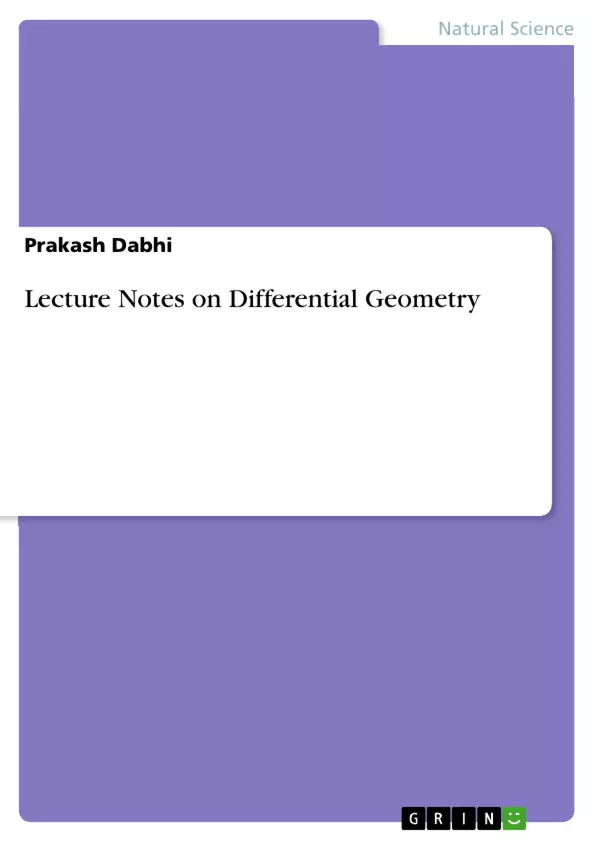This is a Lecture Notes on a one semester course on Differential Geometry taught as a basic course in all M.Sc./M.S. programmes in Mathematics. This consists normally of curve theory leading up to fundamental theorem of space curves as well as the Gauss theory of surfaces covering first fundamental form, second fundamental form, Gaussian curvature, geodesic and Gauss Bonnet theorem. This Lecture Notes is based on lectures I have given to M.Sc. Mathematics students of Sardar Patel University, Vallabh Vidyanagar, India.
Here are the salient features of the Lecture Notes. Proofs of all assertions are completely given in a lucid student friendly manner. A large number of solved exercises are included. All these are to facilitate self study by the students. I have also adopted the modern approach to develop the classical topics treated here. The Lecture Notes is highly influenced by the approach adopted in Elementary Differential Geometry by Andrew Pressley and Differential Geometry of Curves and Surfaces by Manfredo P. do Carmo. I am indebted to these authors whose work have influenced my learning of the subject as well as the preparation of this Lecture Notes. I hope this little book would invite the students to the subject of Differential Geometry and would inspire them to look to some comprehensive books including those mentioned above.
Frequently asked questions
What is the focus of this language preview?
This is a comprehensive language preview which includes the title, table of contents, objectives and key themes, chapter summaries, and key words related to a set of lecture notes.
What topics are covered in Chapter 1: Curve Theory?
Chapter 1 covers curves, regular curves, curvature and torsion, the fundamental theorem of space curves, and the isoperimetric inequality and four vertex theorem.
What does Chapter 2: Surfaces in R³ discuss?
Chapter 2 focuses on surfaces, calculus on surfaces, the first fundamental form, local isometries, and conformal maps.
What does Chapter 3: Curvature of a surface discuss?
Chapter 3 covers the second fundamental form, Gaussian curvature, mean curvature, and principal curvatures.
What topics are covered in Chapter 4: Geodesics and some fundamental results?
Chapter 4 includes Christoffel's Symbols and tangent vector fields, geodesics, Codazzi-Mainardi and Gauss equations, and the Gauss-Bonnet Theorem.
What does the text define as a "regular curve"?
A regular curve at a point is defined as a parametrized curve where the derivative at that point is not equal to zero. A curve is regular if all its points are regular points.
What is a "unit-speed curve"?
A unit-speed curve is a parametrized curve where the speed (magnitude of the derivative) is equal to 1 for all values of the parameter.
What are Christoffel symbols?
Christoffel symbols are functions (denoted as ) used to describe the rate of change of tangent vector fields on a surface. They are used in equations related to geodesics and curvature.
What is Gaussian curvature?
Gaussian curvature (K) is a measure of the intrinsic curvature of a surface at a point. It is the product of the principal curvatures.
What is Mean curvature?
The mean curvature (H) of a surface is the average of the principal curvatures at a point.
What are principal curvatures and principal vectors?
Principal curvatures are the maximum and minimum normal curvatures at a point on a surface. Principal vectors (or directions) are the tangent vectors corresponding to these maximum and minimum normal curvatures.
What is the Gauss-Bonnet Theorem?
The Gauss-Bonnet Theorem relates the integral of the Gaussian curvature over a region on a surface to the geodesic curvature of its boundary and the Euler characteristic.
What are the Codazzi-Mainardi equations?
The Codazzi-Mainardi equations are a set of differential equations that provide relationships between the first and second fundamental forms of a surface.
What is the First Fundamental Form?
It is a quadratic form on the tangent space of a surface that defines the inner product of tangent vectors, allowing for the calculation of lengths of curves and angles on the surface.
What is the second fundamental form?
The second fundamental form is used to describe the curvature of a surface with respect to its normal vector.
- Quote paper
- Dr./Ph.D. Prakash Dabhi (Author), 2015, Lecture Notes on Differential Geometry, Munich, GRIN Verlag, https://www.grin.com/document/303166



